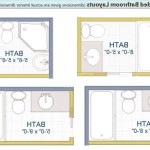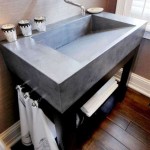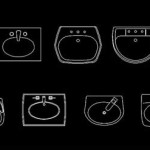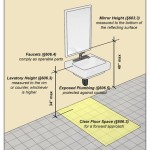Best Bathroom Faucets For Small Sinks
Choosing the right bathroom faucet for a small sink requires careful consideration. The best option balances functionality, aesthetics, and spatial efficiency. A poorly chosen faucet can overwhelm a small sink, making the space feel cramped and hindering usability. Conversely, the correct faucet can enhance the sink's appearance and improve the overall bathroom experience. This article examines key features and popular faucet types to aid in selecting the optimal faucet for smaller bathroom sinks.
Limited counter space around small sinks necessitates a faucet that doesn't dominate the area. Factors like spout reach, height, and handle design are especially important. A faucet with an overly long spout might cause splashing, while an excessively tall faucet can appear disproportionate and visually clutter the space. Similarly, bulky handles can further reduce usable counter space. Considering these dimensions prior to purchase ensures a harmonious and functional installation.
Key Considerations When Selecting a Faucet for Small Sinks
Several crucial elements must be evaluated before deciding on a bathroom faucet for a small sink. Focusing on these aspects will improve the likelihood of selecting a faucet that meets practical and aesthetic needs.
Size and Proportion
The primary concern when selecting a faucet for a small sink is size. It is vital to measure the sink dimensions, including the basin depth, width, and the distance from the faucet hole to the edge of the sink. These measurements inform the selection of a faucet with a suitable spout reach. A spout that extends too far will lead to water splashing over the sink edges, creating a mess and potentially damaging surrounding surfaces. Conversely, a spout that is too short may result in awkward reaching and inefficient use. The faucet's height should also be proportional to the sink depth. A tall faucet on a shallow sink can appear ungainly. Low-profile faucets often work best with small sinks, providing adequate water flow without overwhelming the visual space. Consider faucets specifically designed for compact spaces. These models often feature shorter spouts and lower profiles, maximizing functionality without sacrificing aesthetics.
Faucet Style and Compatibility
Faucet styles range from traditional to contemporary, with each style offering unique design elements. Common styles include centerset, widespread, single-hole, and wall-mounted faucets. Centerset faucets, with handles and spout mounted on a single base, are a popular choice for small sinks as they occupy less space. Widespread faucets, with separate handles and spout, can work but require sufficient counter space. Single-hole faucets offer a minimalist look and are ideal for sinks with only one pre-drilled hole. Wall-mounted faucets are an excellent space-saving option, as they eliminate the need for deck-mounted hardware and free up counter space. The faucet style should complement the overall bathroom decor. Matching the faucet finish to other bathroom fixtures, such as towel bars and light fixtures, creates a cohesive and visually appealing design. Chrome, brushed nickel, and matte black are popular finishes, each offering a distinctive aesthetic. Consider the sink's material and shape when choosing a faucet style. A modern, angular sink might pair well with a sleek, minimalist faucet, while a more traditional, rounded sink might benefit from a classic, curved faucet design.
Functionality and Water Efficiency
Beyond aesthetics, faucet functionality is paramount. Look for faucets with smooth and easy-to-operate handles. Single-handle faucets are often preferred for their ease of use, allowing for temperature and flow control with one hand. Dual-handle faucets provide separate controls for hot and cold water. Consider the water flow rate of the faucet. WaterSense-certified faucets meet EPA standards for water efficiency, using a maximum of 1.5 gallons per minute (GPM). These faucets conserve water without compromising performance. Choosing a faucet with aerated water flow can also improve water efficiency. Aerators mix air with water, reducing water consumption while maintaining a consistent water pressure. Durability is another critical factor. Look for faucets made from high-quality materials, such as solid brass or stainless steel. These materials are less prone to corrosion and provide long-lasting performance. Check customer reviews and ratings to assess the faucet's reliability and ease of maintenance.
Popular Faucet Types for Small Sinks
Different faucet types offer varied benefits for smaller sink configurations. Selecting the correct type depends on the sink's design and desired aesthetic.
Centerset Faucets
Centerset faucets are among the most common choices for small bathroom sinks. They are characterized by their integrated design, where the spout and handles are mounted on a single base unit. This compact configuration makes them suitable for sinks with limited counter space. Centerset faucets are generally easy to install, requiring only three holes in the sink or countertop: one for the spout and two for the handles. The distance between the handle holes is typically 4 inches. Centerset faucets are available in a wide range of styles, from traditional to contemporary, offering flexibility in design. Many models feature a pop-up drain, which is a convenient feature for controlling the sink drain. When selecting a centerset faucet, pay attention to the spout height and reach. A lower spout height can prevent splashing, while an appropriate spout reach ensures that water flows directly into the sink basin. Consider the handle design as well. Lever handles are often easier to operate than knob handles, especially for individuals with limited dexterity.
Single-Hole Faucets
Single-hole faucets, also known as single-lever faucets, are a minimalist and space-saving option for small sinks. They require only one hole in the sink or countertop, providing a clean and uncluttered look. Single-hole faucets typically feature a single handle that controls both water temperature and flow. This simplifies operation and makes them ideal for users of all ages. Single-hole faucets are available in a variety of styles, including modern, traditional, and transitional designs. The sleek and streamlined appearance of single-hole faucets complements contemporary bathroom decor. When selecting a single-hole faucet, consider the spout height and reach, as well as the handle design. A taller spout can provide more clearance for washing hands, while an appropriate spout reach prevents water from splashing outside the sink. Opt for a faucet with a smooth and easy-to-operate handle for optimal functionality. Some single-hole faucets include a deck plate, which covers any unused holes in the sink or countertop. This is a useful feature if you are replacing an older faucet with a single-hole model.
Wall-Mounted Faucets
Wall-mounted faucets offer a unique and space-saving solution for small bathroom sinks. By mounting the faucet on the wall above the sink, they eliminate the need for deck-mounted hardware, freeing up valuable counter space. Wall-mounted faucets create a clean and modern aesthetic, making them a popular choice for contemporary bathrooms. Installation of wall-mounted faucets requires careful planning, as plumbing connections need to be routed through the wall. It is often best to install a wall-mounted faucet during a bathroom renovation, when the wall is already open. Wall-mounted faucets are available in a variety of styles, including single-handle and dual-handle models. When selecting a wall-mounted faucet, consider the spout reach and height. The spout should extend far enough into the sink basin to prevent splashing, but not so far that it interferes with the sink's usability. The height of the faucet should be appropriate for the sink depth. Ensure that the wall-mounted faucet is compatible with the sink's design. A modern, minimalist sink might pair well with a sleek, angular faucet, while a more traditional sink might benefit from a curved, ornate faucet design.
Materials, Finishes, and Durability
The materials and finishes used in bathroom faucets significantly impact their longevity and aesthetic appeal. Selecting durable materials and appropriate finishes ensures that the faucet withstands daily use and maintains its appearance over time.
Faucet Materials
Brass is a widely used material for bathroom faucets due to its durability and resistance to corrosion. Solid brass faucets are less susceptible to leaks and can withstand high water pressure. Stainless steel is another popular choice, offering excellent corrosion resistance and a modern aesthetic. Stainless steel faucets are easy to clean and maintain. Some faucets are made from zinc alloy, which is a less expensive alternative to brass and stainless steel. However, zinc alloy faucets may not be as durable and may be more prone to corrosion. Ceramic disc valves are commonly used in modern faucets. These valves provide a tight seal, preventing drips and leaks. Ceramic disc valves are also highly durable and can with-stand millions of uses. The valve material is a critical component contributing to faucet longevity.
Faucet Finishes
Faucet finishes not only enhance the appearance of the faucet but also protect it from wear and tear. Chrome is a classic and versatile finish that complements a wide range of bathroom styles. Chrome finishes are durable and easy to clean. Brushed nickel is another popular finish, offering a softer, more muted look than chrome. Brushed nickel is resistant to fingerprints and water spots, making it a practical choice for busy bathrooms. Oil-rubbed bronze provides a warm and rustic aesthetic. Oil-rubbed bronze finishes are often used in traditional and transitional bathroom designs. Matte black is a contemporary finish that adds a touch of sophistication to any bathroom. Matte black finishes are resistant to scratches and fingerprints, but may require more frequent cleaning to remove water spots. PVD (Physical Vapor Deposition) finishes are highly durable and resistant to corrosion, tarnishing, and scratches. PVD finishes are available in a variety of colors and styles, offering a wide range of design options.
Durability and Maintenance
Durability is a crucial consideration when selecting a bathroom faucet. A well-made faucet should last for many years with proper care. Look for faucets with a solid construction and high-quality materials. Check customer reviews and ratings to assess the faucet's reliability and longevity. Regular cleaning and maintenance can help to extend the life of your bathroom faucet. Clean the faucet regularly with a mild soap and water solution. Avoid using abrasive cleaners, as they can damage the finish. Dry the faucet after each use to prevent water spots and mineral buildup. Inspect the faucet regularly for leaks or drips. Address any issues promptly to prevent further damage. Periodic maintenance, such as replacing worn-out washers or O-rings, can help to keep your faucet in good working condition.

Best Bathroom Faucets For Your Home The Depot

The Best Bathroom Faucets Of 2024 Top Picks From Bob Vila

The Best Bathroom Faucets Of 2024 Top Picks From Bob Vila

How To Choose A Bathroom Faucet Delta Blog

Best Bathroom Faucets For Your Home The Depot

51 Bathroom Faucets To Complete Your Dream Sink Update

Best Bathroom Faucets For Your Home The Depot

Best Bathroom Sink Faucets Of December 2024 Forbes Home

35 Best Bathroom Faucets Of 2024 Top Picks

Best Bathroom Faucets For Your Home The Depot







